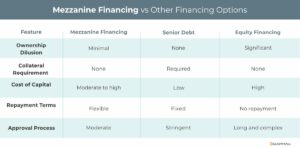
Mitigating Risk While Funding Growth with Mezzanine Financing
Content
Businesses in high-growth phases, particularly during economic uncertainty, need flexible financing solutions to access capital without overburdening their balance sheets. Effective cash flow management, coupled with a strategic blend of short-term debt and equity, can help mitigate risks while funding expansion initiatives.
Mezzanine financing offers a hybrid funding option that combines elements of debt and equity, bridging financial gaps and supporting business growth. With its flexible structure, minimal ownership dilution, and ability to unlock significant capital, this financing model is an attractive option for ambitious companies.
However, mezzanine financing comes with complexities that require careful management. While it provides flexibility and access to capital without excessive equity dilution, businesses must fully understand its structure and costs. This guide explores mezzanine financing, its mechanics, benefits, and how it can empower businesses to achieve their strategic objectives.
What Is Mezzanine Financing?
Mezzanine financing is a form of subordinated debt that often includes an equity component, such as warrants or options. It sits between senior debt and equity in a company’s capital structure, offering a flexible alternative to businesses looking to raise capital without taking on the restrictive covenants of senior loans or full equity dilution.
Key Features:
- Subordinated Debt – This financing option is repaid after senior debt but before equity holders in the event of liquidation.
- Equity Component – Typically includes warrants or options, allowing lenders to benefit from the company’s success.
- Unsecured – Usually does not require collateral, relying instead on the business’s cash flow and growth potential.
How Does Mezzanine Financing Work?
- Application and Assessment – Businesses demonstrate their financial strength, growth plans, and cash flow capabilities to potential lenders.
- Capital Deployment – The mezzanine lender provides funding, often in larger amounts than traditional loans.
- Repayment Structure – Businesses make interest payments, and in some cases, lenders may convert part of the debt into equity if predefined conditions are met.
Advantages of Mezzanine Financing
- Access to Substantial Capital
- Provides funding for major initiatives such as mergers, acquisitions, and expansion.
- Minimal Equity Dilution
- Unlike full equity financing, mezzanine financing allows business owners to retain majority control.
- Flexible Repayment Terms
- Interest-only periods or structured repayments align with the company’s cash flow, reducing financial strain.
- Enhances Leverage
- Often used as gap funding alongside senior debt or equity, maximising available resources.
- Tax Efficiency
- Interest payments on mezzanine debt are usually tax-deductible, lowering the overall cost of capital.
Drawbacks of Mezzanine Financing
- Higher Costs
- The combined cost of debt and equity components makes mezzanine financing more expensive than senior debt.
- Subordination Risk
- Mezzanine lenders face higher risk since they rank below senior creditors, leading to stricter terms and covenants.
- Potential Dilution
- While less than full equity financing, warrants or options can lead to some ownership dilution if exercised.
- Cash Flow Dependence
- Strong, predictable cash flow is essential to meet repayment obligations.
When Is Mezzanine Financing an Ideal Solution?
- Business Expansion
- A company looking to open new locations or scale operations can use mezzanine financing to bridge funding gaps.
- Mergers and Acquisitions (M&A)
- A common funding tool for acquisitions, allowing businesses to fund deals without overleveraging or losing control.
- Management Buyouts (MBOs)
- Enables management teams to acquire ownership stakes without exhausting available cash reserves.
- Recapitalisation
- Businesses seeking to restructure debt or optimise their capital structure often turn to mezzanine financing.
Understanding the right financing strategy for your company is crucial, and working with a specialist lender ensures you receive a tailored approach that aligns with your growth objectives.
Real-World Example: Mezzanine Financing in Action
Scenario:
A mid-sized UK-based manufacturing company plans to acquire a competitor but lacks the full capital required. Senior debt covers 70% of the acquisition cost, leaving a 30% funding gap.
Solution:
The company secures mezzanine financing for the remaining 30%, agreeing on a fixed interest rate and warrants granting the lender equity options. The acquisition increases market share and revenue, allowing the company to repay the mezzanine debt within five years while retaining majority ownership.
Outcome:
The business successfully integrates the competitor, enhances profitability, and positions itself as an industry leader.
Choosing the Right Mezzanine Financing Partner
- Industry Expertise
- Select a lender with experience in your industry to ensure tailored advice and favourable terms.
- Transparent Terms
- Clearly define repayment schedules, interest rates, and equity components before committing.
- Flexibility
- Opt for lenders that align repayment terms with your company’s cash flow cycles.
- Reputation
- Research lender track records, client reviews, and case studies to assess reliability.
Conclusion
Mezzanine financing is a powerful tool for businesses seeking flexible, growth-oriented funding. By blending debt and equity, this financing model allows companies to access significant capital while retaining control over their operations.
However, due to its higher costs and risks, mezzanine financing should be carefully evaluated as part of a broader financial strategy. Whether expanding operations, acquiring competitors, or restructuring capital, this form of subordinated debt can serve as a valuable bridge to long-term success.
Is mezzanine financing the right option for your business? Consulting financial experts will help tailor a financing strategy that aligns with your goals.
Contact us to explore the flexible financing options available to support your company’s growth and sustainability in dynamic economic conditions.
Key Takeaways
- Mezzanine financing allows businesses to raise capital without excessive dilution or restrictive covenants.
- Ideal for expansion, acquisitions, MBOs, and restructuring initiatives.
- While mezzanine financing unlocks growth potential, it comes with higher costs and risks that must be managed effectively.



